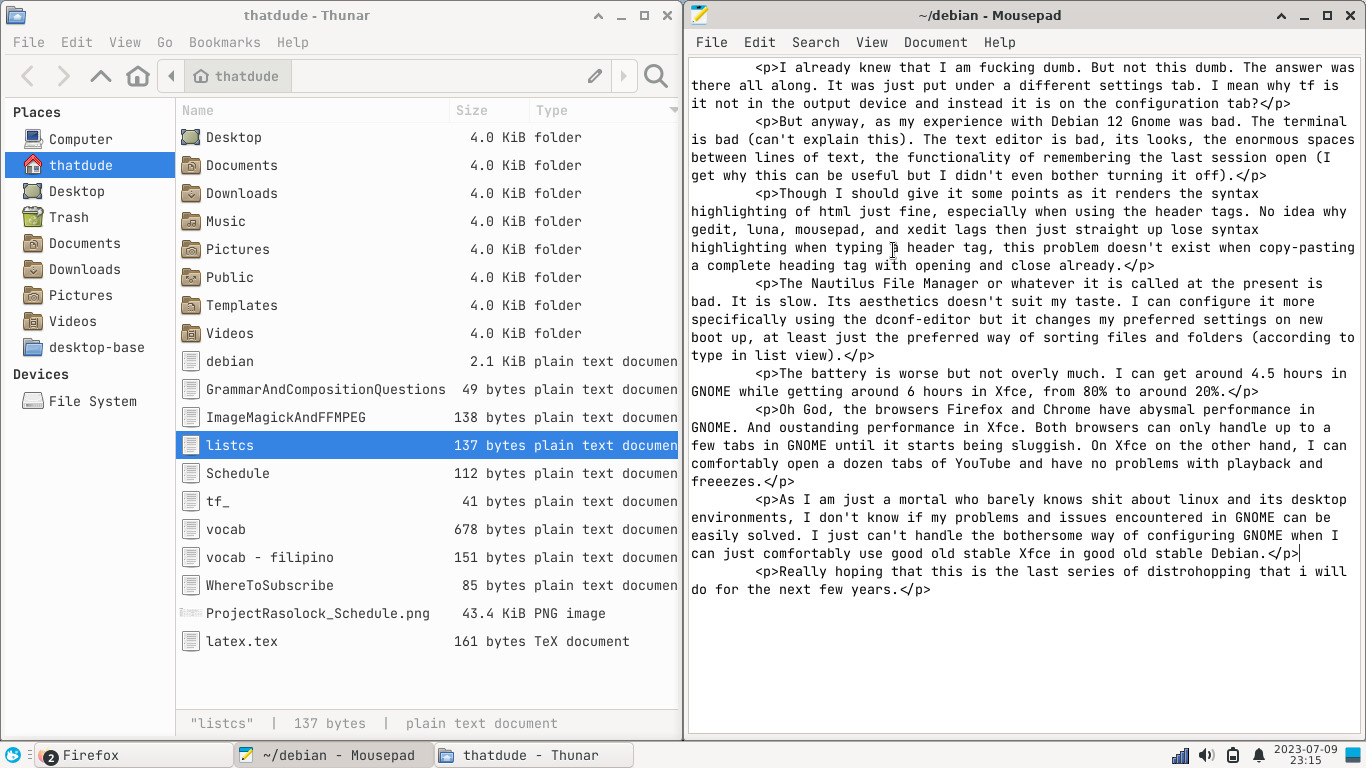2023-04-25
Distrohopping is a good move of the new user who fairly got used to their system. It gives them the freedom of choice based on what they want their system to be, their uses, and priorities. In my case, as I am just a casual user, not even a gamer, and my machine is a low-end celeron laptop with 128gb emmc, and 8gb ram, Linux Mint Cinnamon takes the cake.
Though I have distropped numerous times to get the best of my machine, have the best comfort and speed, I ended up with Mint. Here is my experience with other distros. A thing to take not is I usually don't configure my system that much. I mostly use the defaults.
Linux Mint XFCE is great as it is stable, fast, and does not consume much resources. The only problem I had is with connecting to external display. Closing off the lid turns off the external display. Though I did try to fix this problem, I did not spend that much time. Can handle lots of tabs in Chrome and Firefox (this is what I mostly work with, where I spend my time with and do most of my studies).
Fedora KDE. Fast enough to be of use. But bloated to the point that just a few tabs in Chrome and Firefox is enough to slow it down. Consumes more power (watts) than LM XFCE and LM Cinnamon. Has a great text editor though. Default theming and appearance is great.
Fedora Gnome. Bloated and very slow. Lags with just a a few tabs in both browsers. File manager is not as configurable (even with dconf-editor, and some settings/preferences(?) does not even apply even after reboot). Default gnome text editor sucks.
Fedora Mate. Good enough but LM Cinnamon is aesthetically better. Large updates size.
Fedora i3. Good and fast enough but I don't want to deal with a Window Manager only as I don't want to memorize much keybindings. I have practically nothing to gain with using a WM over a DE like Cinnamon.
Ubuntu. Did not even bother as it also features the Gnome DE. I know it has other flavors.
Xubuntu. Somehow the live install media was broken even though I made sure the checksum matched. Flashed it twice.
Lubuntu. Window tiling is not existent. Screenshot utility is not good enough. The text editor is good though.
Debian XFCE. From what I can remember, it consumes too much power (even with tlp enabled).
Arch i3 and sway. Same reason as fedora i3.
Manjaro. I have used it a long time ago (on my last laptop), and did not have a good experience. I mean it was fast enough (XFCE) but the updates are too often and some problems arose from these updates. I don't want to deal with a system that needs manual intervention that often.
Fedora has slow package manager, has 6-month release cycle (too fast in my use case as I have no need for latest or semi-latest packages).
Arch, I don't want to configure it that much. The updates are too often, broke my system a few times and left the Archland. Though my internet speed is fast enough, I don't want to waste much bandwidth and resources for very large updates. I also have no need for the latest packages.
Debian, Ubuntu, and Mint, fits my needs as it is stable, does not need manual intervention, long-term releases, trustworthy enough as not to break in between updates.
I already knew that I am fucking dumb. But not this dumb. The answer was there all along. It was just put under a different settings tab. I mean why tf is it not in the output device and instead it is on the configuration tab?
But anyway, as my experience with Debian 12 Gnome was bad. The terminal is bad (can't explain this). The text editor is bad, its looks, the enormous spaces between lines of text, the functionality of remembering the last session open (I get why this can be useful but I didn't even bother turning it off).
Though I should give it some points as it renders the syntax highlighting of html just fine, especially when using the header tags. No idea why gedit, luna, mousepad, and xedit lags then just straight up lose syntax highlighting when typing a header tag, this problem doesn't exist when copy-pasting a complete heading tag with opening and close already.
The Nautilus File Manager or whatever it is called at the present is bad. It is slow. Its aesthetics doesn't suit my taste. I can configure it more specifically using the dconf-editor but it changes my preferred settings on new boot up, at least just the preferred way of sorting files and folders (according to type in list view).
The battery is worse but not overly much. I can get around 4.5 hours in GNOME while getting around 6 hours in Xfce, from 80% to around 20%.
Oh God, the browsers Firefox and Chrome have abysmal performance in GNOME. And oustanding performance in Xfce. Both browsers can only handle up to a few tabs in GNOME until it starts being sluggish. On Xfce on the other hand, I can comfortably open a dozen tabs of YouTube and have no problems with playback and freeezes.
As I am just a mortal who barely knows shit about linux and its desktop environments, I don't know if my problems and issues encountered in GNOME can be easily solved. I just can't handle the bothersome way of configuring GNOME when I can just comfortably use good old stable Xfce in good old stable Debian.
Really hoping that this is the last series of distrohopping that i will do for the next few years.

